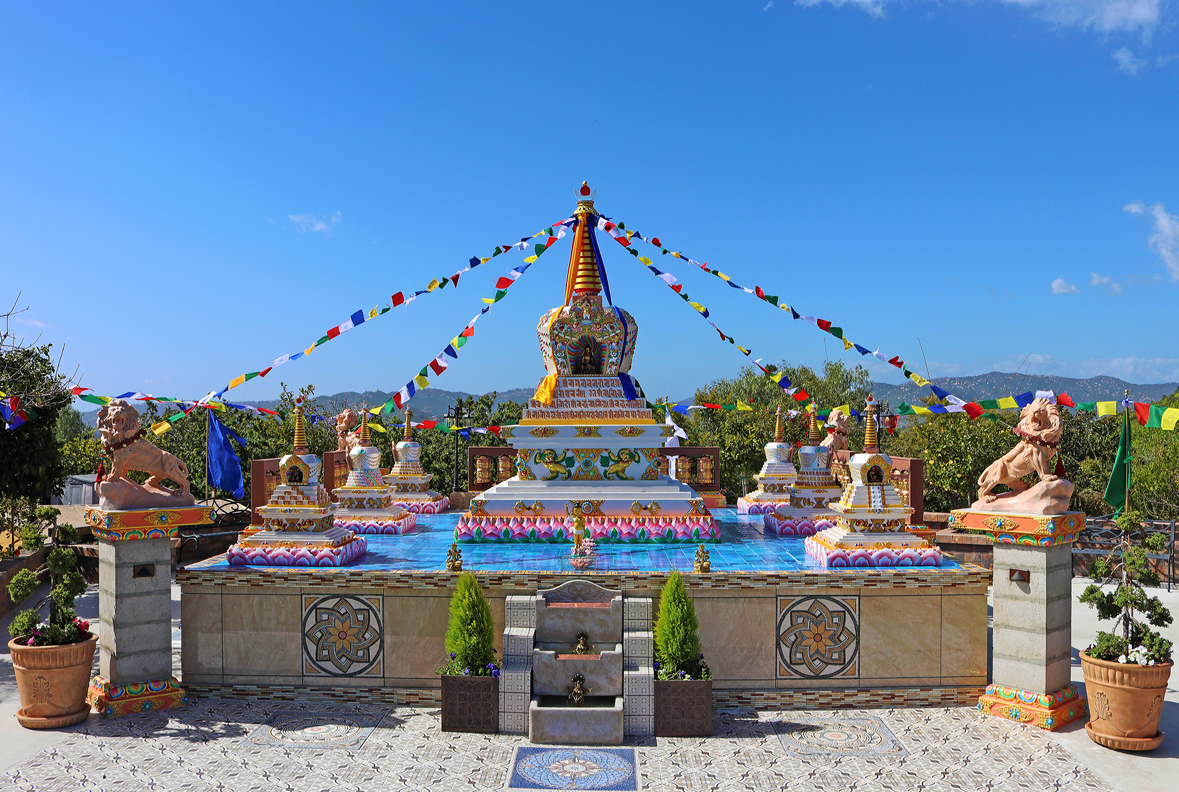DKC
Stupa of Enlightenment
Enlightenment Stupa at Drikung Kyobpa Choling, located on the hill top with beautiful surrounding views where the blessings of this holy object emanate for the benefit of world peace and spiritual inspiration both near and far. There is a total of 8 stupas representing the 8 major deeds in the life of the Buddha.
Please consider donating to maintain the beautiful Stupas dedicated for world peace.
In Buddhism, a Stupa is a monument which represents peace, prosperity and harmony, as well as being a place for meditation. The Enlightenment Stupa symbolizes Buddha's enlightenment, the realization of the nature of mind, and is one of the eight different forms that Stupas are built according to.
In Tibetan Buddhism, the building of stupas (chorten in Tibetan) came to be an important part of the spiritual tradition.
The symbolism of the form of the stupas is a vast and complex subject, as is the meaning behind every item placed within a stupa.
The shape of the stupa represents the Buddha, crowned and sitting in meditation posture on a lion throne. The stupa also symbolizes the five elements and colors andtheir relationship to Enlightened Mind:
Base – Square – Yellow – Earth - Equanimity
Dome – Circle – White – Water - Indestructibility
Spire – Triangle – Red – Fire – Compassion
Parasol – Half Circle – Green – Wind – All- accomplishing Action
Jewel – Dewdrop (no shape/no color/void) – Space – All-pervading Awareness
'It is through the language of archetypal symbols that we reconnect ourselves with the primordial ground from which all human culture has sprung... Among the oldest of architectural forms, the Stupa is a universal symbol of enlightened mind, a familiar sight in all countries where Buddhism has flourished. In the Stupa we find the ancient reliquary monuments once built for kings and heroes transformed into profound expressions of knowledge. Rightly interpreted and understood by both reason and intuition, it mirrors the harmony and perfection of universal principles and invites the human mind to awaken its full capabilities...'. This quotation gives us a taste of why Stupas were built and what they signify now and in former times. They are the most fascinating structures on the planet. Their development mirrors that of our cultures, and their transformation stands as a witness to the changes in our philosophical concepts.
Stupas became a multi-purpose symbol, a real treasure of knowledge about phenomena, the universe, the nature of our mind and the way leading to the state of full development or enlightenment. Through its form, and through the 'jewels' which are placed inside of it, a Stupa works with us on many different conscious and subconscious levels. Stupas are energy generators and transformers. They take energy from nature and focus and redistribute it. It is believed that Stupas have great protective power. Being filled with positive energy, they pacify and transform sources of negative power.
One of our goals as developed humans is to protect those who need protection. By helping to build a Stupa we can add our 'brick' in a joint effort towards the realization of this goal. As purely symbolic structures - Stupas are not temples or ordinary buildings - they invite us to think and meditate about their message. In this way, they are animators of our development in varied fields of endeavor, such as religion, philosophy, history, geography, archeology and mind itself. Once built, they rest on their stone foundation, unchangeable and free from the influence of social and political events and turbulence. Because of these profound effects, Stupas are one of the most useful buildings we can construct.
According to the Buddhist teachings there are 8 different types of Tibetan Stupas. Each of them represents an important event in Buddha Shakyamuni’s life story. The Enlightenment Stupa (or Chan Chub Chorten in Tibetan) symbolizes the achievement of Buddha's enlightenment, the nature of a fully awakened mind.
Each of the 8 different Stupa types is built according to very precise instructions where the exact design and proportions have to be strictly followed. The outer structure has a deep significance at many levels and its inner containers (treasure chambers) are filled with symbolical objects. The Stupa has consequently been charged up by powerful ceremonies performed by Lamas.
Stupas are normally closed monoliths, which believers circumambulate and express their wishes as being in front of Buddha himself. To absorb its beneficial influence into our lives it is recommended to walk around the Stupa in a clock wise direction. Buddhists believe that wishes done near a Stupa may become true.
8 Great Deeds
Since the Buddha’s passing, the stupas that have been built are representations of his form and memorials of his 8 Great Deeds. The structures are constructed according to guidelines found in Buddhist scripture that he left. Many stupas today are built on these representations.





